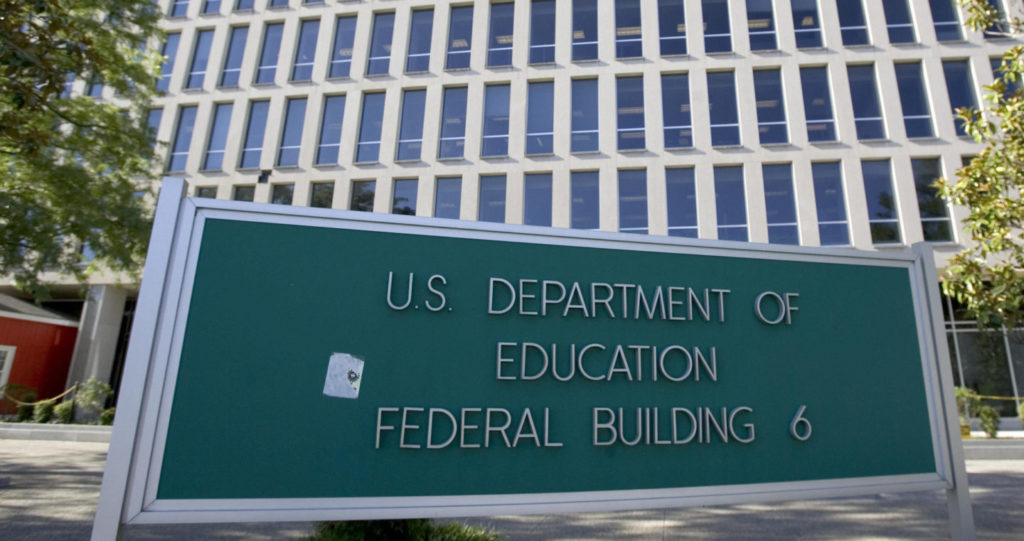Calls to abolish U.S. Department of Education not as radical as you’d think
Former President Donald Trump has promised to eliminate the U.S. Department of Education if re-elected.
“We’re also moving the Department of Education back to the states,” Trump said in…

Former President Donald Trump has promised to eliminate the U.S. Department of Education if re-elected.
“We’re also moving the Department of Education back to the states,” Trump said in June. “We’re at the bottom of every list, except we spend more per pupil than any other country. And we’re gonna move it back [to the states].”
The idea may sound radical, but the department’s history is full of controversy about its necessity – and constitutionality.
What does the Education Department do?
According to its website, the goal of the U.S. Department of Education (ED) is to “promote student achievement and preparation for global competitiveness by fostering educational excellence and ensuring equal access.”
Its four main objectives are:
- Distributing funds to both K-12 and higher education institutions
- Collecting data and conducting research
- Ensuring equal access to and countering discrimination in public schools
- Bringing attention to national issues regarding education
While state education departments vary, they play a much larger role in managing public education. State superintendents and school boards make decisions about learning standards, teacher licensing, charter schools and school choice programs , while enforcing a variety of state regulations.
In contrast, a large part of the ED’s function is simply shuffling tax dollars.
A government spending watchdog estimates the vast majority of ED’s budget goes to the Offices of Federal Student Aid, Elementary and Secondary Education, and Special Education and Rehabilitative Services.
ED provides roughly $85 billion in annual funding to K-12 public schools and $31 billion in various college grants (not including student loans), the Education Data Initiative reported.
Comparatively little is spent on the Office of Innovation and Improvement or the Institute of Education Sciences – which was supposed to be the sole purpose of the department.
‘No authority to interfere with education’
Though the current form of the ED didn’t exist until 1979, its history traces back to 1867.
A coalition of superintendents wanted the government’s help compiling data about schools nationwide. The proposed department would be purely informational, have no authority to impose mandates, and would not distribute funds.
As one supportive congressman put it at the time: “While it will have no power to enter into the states and interfere with their systems, it will be able to collect facts and report the same to Congress, to be thence spread over the entire country.”
Still, others were, rightly as it turned out, concerned about government overreach and violating the 10th Amendment.
“There is no authority under the Constitution of the United States to authorize Congress to interfere with education of children of the different states in any manner, directly or indirectly,” said an opponent.
The 10th Amendment reserves to the states or the people all powers not expressly delegated to the federal government by the Constitution.
Proponents of the education office prevailed, though it remained a small office housed in other departments until its expansion into a full department in the late 20th century.
But its expansion ended up being just as controversial as its establishment.
‘Abolish the Department of Education’
Just a few short years after the ED’s modern creation, President Ronald Reagan tried to eliminate, arguing it contributed to the overgrowth of federal grants.
“The budget plan I submit to you on February 8th will realize major savings by dismantling the Departments of Energy and Education and by eliminating ineffective subsidies for business,” Reagan said in his 1982 State of the Union address.
“In 1960 the Federal Government had 132 categorical grant programs, costing $7 billion. When I took office, there were approximately 500, costing nearly a hundred billion dollars – 13 programs for energy, 36 for pollution control, 66 for social services, 90 for education. And here in the Congress, it takes at least 166 committees just to try to keep track of them.”
He blamed the increase in federal power for citizens feeling disconnected from their local institutions.
“Our citizens feel they’ve lost control of even the most basic decisions made about the essential services of government, such as schools, welfare, roads, and even garbage collection. And they’re right. A maze of interlocking jurisdictions and levels of government confronts average citizens in trying to solve even the simplest of problems. They don’t know where to turn for answers, who to hold accountable, who to praise, who to blame, who to vote for or against.”
Reagan wasn’t the first to call for abolishing – or at least drastically reducing – the ED, and he certainly wasn’t the last.
In 1996, the GOP party platform included the following:
“The Federal government has no constitutional authority to be involved in school curricula or to control jobs in the market place. This is why we will abolish the Department of Education.”
More recently, presidential hopefuls such as Florida Gov. Ron DeSantis and Vivek Ramaswamy expressed their desires to get rid of the ED.
As noted by Jonathan Butcher, senior research fellow in education policy at The Heritage Foundation, presidential leadership would have to align with legislative support to make such changes happen.
“There would have to be some legislation to specifically outline this, but I do think it would need to have the support of the executive branch, and obviously, this is a Cabinet-level agency, so I think [the president] would have to take a leadership role and help to make sure that the proposal is carefully crafted,” Butcher told The Hill.
He further suggested important functions of the ED could easily be reassigned to other agencies.
For example, discrimination complaints which currently go to the ED’s Office of Civil Rights could be moved to the Department of Justice, and student loans could be handled by the Department of the Treasury.



